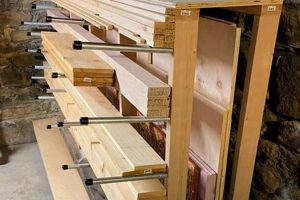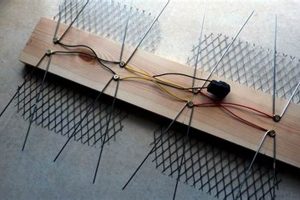A self-assembled apparatus designed to perform resistance welding on a localized area, typically constructed from readily available components. This device allows for the fusion of overlapping metal sheets by applying a controlled electric current and pressure to a small point.
The creation of such a device provides a cost-effective alternative to commercially manufactured spot welders, enabling fabrication and repair work in scenarios where budget or accessibility is a constraint. Its roots lie in the maker movement and the desire for accessible tools, empowering individuals to undertake metalworking projects at home or in small workshops.
The following sections will detail the core components, construction methodologies, safety considerations, and potential applications relevant to building and utilizing a personalized point welding system.
Essential Considerations for Fabricating a Resistance Welding Device
The successful construction and operation of a localized fusion welding apparatus demand careful attention to several key aspects. These considerations directly impact the performance, safety, and longevity of the equipment.
Tip 1: Select a Robust Transformer: The transformer is the heart of the system. Prioritize one with a sufficient current output capacity, typically salvaged from microwave ovens or battery chargers, to ensure adequate weld strength. Underpowered transformers result in weak or incomplete welds.
Tip 2: Optimize Electrode Material and Geometry: Copper electrodes are preferred for their high conductivity and resistance to sticking. The electrode tip geometrypointed, rounded, or flatshould be tailored to the thickness and type of materials being joined. Experimentation is often required.
Tip 3: Implement Precise Timing Control: A precisely controlled timer is crucial to regulate the current duration. Excessive current can cause burn-through, while insufficient current leads to weak welds. Solid-state relays (SSRs) coupled with a timer circuit provide reliable control.
Tip 4: Ensure Adequate Pressure Application: Consistent and sufficient pressure is essential for proper fusion. A lever mechanism or a foot pedal setup facilitates controlled pressure application during the welding process. Inconsistent pressure results in variable weld quality.
Tip 5: Incorporate Safety Features: Implement safeguards against electrical shock, including proper grounding, insulation, and a readily accessible emergency shut-off switch. Eye protection and appropriate ventilation are also paramount. Safety should be the foremost consideration.
Tip 6: Calibrate and Test Thoroughly: Before commencing production welding, rigorously test the device on scrap materials to determine optimal current settings, pressure levels, and weld durations. This calibration process minimizes defects and ensures consistent results.
Tip 7: Consider Cooling Mechanisms: High currents can generate substantial heat. Incorporating cooling mechanisms, such as forced air or liquid cooling, can prevent overheating of the transformer and electrodes, extending their lifespan and improving performance.
Adherence to these guidelines enhances the effectiveness and safety of a self-assembled resistance welding device, enabling reliable metal joining for a wide range of projects.
The concluding section will summarize the key advantages and potential applications of this technology.
1. Transformer amperage
Transformer amperage constitutes a critical parameter in the functionality of a self-assembled resistance welding device. The amperage rating dictates the maximum electrical current that the transformer can supply, directly influencing the heat generated at the welding point. Insufficient amperage will result in inadequate heating, leading to weak or incomplete welds. Conversely, excessive amperage can cause burn-through or material deformation.
Consider a scenario where a user attempts to weld two pieces of 18-gauge steel using a transformer with a low amperage output, such as one salvaged from a small appliance. The resulting welds would likely be weak and unreliable due to insufficient heat generation at the welding interface. In contrast, employing a transformer with a higher amperage rating, sourced from a microwave oven or battery charger, would provide the necessary current to create a strong and durable bond. Practical applications, such as automotive sheet metal repair or custom metal fabrication, demand precise amperage control for optimal results.
Therefore, selecting a transformer with an appropriate amperage rating is paramount for successful point welding. The amperage requirement depends on the material type and thickness being welded. Careful consideration of this parameter mitigates welding defects and ensures structural integrity of the joined materials. Optimizing transformer amperage remains a central challenge to the effective assembly and operation of these devices.
2. Electrode material
Electrode material is a crucial determinant of performance in self-constructed resistance welding apparatus. The material composition of the electrodes directly influences electrical conductivity, heat dissipation, and resistance to wear. Improper material selection results in inefficient welding, inconsistent weld quality, and premature electrode failure. The choice of electrode material constitutes a foundational element in the design and implementation of effective welding practices.
Copper and its alloys are commonly employed for electrode construction due to their high electrical and thermal conductivity. Copper facilitates the efficient transfer of electrical current to the welding zone while simultaneously dissipating heat away from the contact point, preventing overheating and material degradation. For instance, welding thin-gauge steel requires electrodes with superior heat dissipation to minimize the risk of burn-through. In contrast, welding aluminum, a material with high thermal conductivity, necessitates electrodes with optimized contact surface area and cooling mechanisms to counteract rapid heat absorption. Further, electrodes incorporating tungsten or other refractory metals can enhance wear resistance, particularly in high-volume applications or when welding materials with abrasive surface characteristics.
Selecting the correct electrode material is not merely a matter of availability; it directly impacts weld integrity and operational longevity. Understanding the material properties relevant to resistance welding, alongside the demands of the specific application, enables the construction of devices capable of consistently producing high-quality welds. Ignoring these material properties inevitably leads to suboptimal performance and increased maintenance requirements. The connection between electrode material and effective welding is, therefore, inextricable and fundamental to the succ
ess of any self-constructed point welding project.
3. Timing control
Precise regulation of weld duration, facilitated through effective timing control mechanisms, represents a critical facet in the successful implementation of a self-assembled resistance welding system. The duration for which electrical current flows through the welding point directly influences the heat generated, the extent of material fusion, and the structural integrity of the resulting weld. Inadequate or inconsistent timing control leads to a range of potential welding defects.
- Solid-State Relay (SSR) Integration
An SSR serves as a rapid and reliable switch, controlling the flow of high current based on a low-voltage signal from a timing circuit. Integrating an SSR allows for precise on/off control of the welding current, avoiding the mechanical limitations and potential arcing issues associated with traditional relays. A practical application involves using a microcontroller to generate a precisely timed pulse to activate the SSR, ensuring consistent weld durations across multiple operations. This method proves advantageous in applications demanding repetitive and accurate welds, such as battery tab welding or small component assembly.
- Pulse Width Modulation (PWM) for Current Adjustment
PWM enables fine-grained control over the average current delivered to the welding point. By varying the duty cycle of a square wave signal, PWM modulates the effective current without altering the peak voltage. This method can compensate for variations in material thickness or surface conditions. For example, welding dissimilar metals may require a nuanced adjustment of the current profile to prevent overheating one material while inadequately fusing the other. A PWM-based controller allows for dynamic adaptation of the current based on real-time feedback or pre-programmed welding profiles, ensuring optimal weld quality across a broader range of applications.
- Overcurrent Protection Implementation
Timing control systems often incorporate overcurrent protection features to safeguard both the welding apparatus and the workpiece. These systems continuously monitor the current flow and automatically interrupt the circuit if the current exceeds a pre-defined threshold. This protection mechanism prevents catastrophic failures due to short circuits or excessive current draw, which can damage the transformer or electrodes. An overcurrent protection module typically employs a current sensor and a fast-acting circuit breaker or fuse, ensuring rapid response to fault conditions. The integration of overcurrent protection enhances the safety and reliability of the welding process, minimizing the risk of equipment damage or personal injury.
- Closed-Loop Feedback Systems
Advanced timing control systems can incorporate closed-loop feedback mechanisms, utilizing sensors to monitor parameters such as weld temperature or voltage drop in real-time. This feedback is used to dynamically adjust the welding parameters, such as current or duration, to maintain consistent weld quality. For example, a temperature sensor positioned near the welding point can provide feedback to a microcontroller, which then adjusts the PWM duty cycle to compensate for variations in material thermal conductivity. This adaptive control strategy ensures robust welding performance, even under fluctuating conditions, delivering superior weld strength and minimizing the occurrence of defects. These systems are particularly applicable in high-precision welding operations.
The discussed facets highlight the integral role of timing control in the realm of self-assembled resistance welding. From basic on/off regulation to sophisticated closed-loop systems, precise management of weld duration directly impacts weld quality, safety, and overall device performance. Mastery of timing control techniques allows constructors to optimize their welding apparatus for specific applications, unlocking its full potential and enabling reliable metal joining across a wide spectrum of projects.
4. Pressure consistency
Maintaining consistent pressure during the welding process is paramount to achieving reliable and structurally sound welds in a self-assembled resistance welding device. Variations in applied force directly impact the contact resistance between the workpieces, influencing heat generation and material fusion. Stable and regulated pressure ensures uniform welding characteristics and minimizes the occurrence of defects.
- Leverage and Mechanical Advantage
Simple lever mechanisms or foot-operated presses provide a means of amplifying manual force, allowing for the application of substantial pressure to the welding electrodes. The mechanical advantage gained through these systems reduces the physical effort required and promotes consistent pressure application throughout the weld cycle. Examples include utilizing a repurposed drill press or designing a custom lever arm system. Variability in the applied manual force translates directly into pressure inconsistencies, leading to uneven heat distribution and compromised weld strength.
- Pneumatic or Hydraulic Systems
Pneumatic or hydraulic cylinders offer precise and repeatable force control, enabling the automation of the pressure application process. These systems utilize compressed air or hydraulic fluid to actuate the electrodes, ensuring consistent pressure regardless of operator input. A practical example involves incorporating an adjustable pressure regulator to fine-tune the force exerted by the cylinder. Pressure fluctuations within these systems, due to leaks or inadequate control, can similarly lead to weld inconsistencies.
- Electrode Alignment and Surface Preparation
Proper alignment of the electrodes and meticulous surface preparation of the workpieces contribute significantly to consistent pressure distribution at the welding interface. Misaligned electrodes or uneven surfaces create localized pressure points, resulting in inconsistent heat generation and potential weld failures. Ensuring parallel electrode surfaces and removing surface contaminants like oxides or coatings facilitates uniform contact and optimizes pressure transfer. Deviations in electrode alignment or surface cleanliness compromise the effectiveness of the applied pressure.
- Force Measurement and Feedback Control
Advanced systems can incorporate force sensors to continuously monitor the pressure applied to the weld. This feedback data can be used to dynamically adjust the actuation system, maintaining constant pressure even in the face of material deformation or variations in electrode contact. An example includes integrating a load cell into the electrode assembly to measure the applied force, with a microcontroller adjusting the pneumatic or hydraulic cylinder to maintain a pre-set pressure target. Lack of force measurement and active control makes it challenging to compensate for real-time variations during welding.
In conclusion, consistently applied pressure is an indispensable element for producing high-quality welds when utilizing a self-made resistance welding apparatus. Whether employing manual lever systems, automated pneumatic cylinders, or sophisticated feedback-controlled systems, maintaining pressure uniformity is critical for achieving reli
able and robust metal joining. Addressing electrode alignment, surface preparation, and proper force application methods allows for optimized pressure consistency. Consequently, welding defects can be mitigated, ultimately enhancing the performance and longevity of the welded joints. The direct relationship between consistent pressure and the resulting weld quality dictates careful attention to this parameter during system design, construction, and operation.
5. Safety measures
The construction and operation of a “diy spot welder” intrinsically involve significant hazards, necessitating rigorous adherence to comprehensive safety measures. These measures directly mitigate the risks of electrical shock, burns, eye injuries, and potential fire hazards associated with high-current electrical circuits and molten metal. Ignoring safety protocols introduces a substantial probability of severe harm. The absence of proper insulation, grounding, or protective equipment can result in direct contact with high-voltage components, leading to electrocution. Similarly, inadequate eye protection during operation may result in irreversible retinal damage from intense light and sparks. Furthermore, the proximity of flammable materials to the welding area without appropriate fire suppression measures can trigger uncontrolled conflagrations.
Effective safety strategies include, but are not limited to, implementing a robust grounding system to prevent electrical shocks, utilizing appropriately rated fuses or circuit breakers to protect against overcurrent conditions, wearing certified eye protection (welding goggles or face shields), donning flame-resistant clothing and gloves, and ensuring adequate ventilation to dissipate fumes generated during the welding process. A readily accessible fire extinguisher should be present in the work area. Furthermore, a double-check system, where another individual reviews the setup and procedures, provides an additional layer of protection against potential oversights. Regularly inspecting equipment for wear or damage is imperative, along with immediately addressing any identified deficiencies.
In summary, comprehensive safety measures are not merely an adjunct to the “diy spot welder” project; they constitute an indispensable component. Strict adherence to these protocols is essential for minimizing risk, preventing injury, and ensuring a safe working environment. The potential consequences of neglecting safety considerations far outweigh any perceived convenience or cost savings. The ultimate success of any self-constructed welding apparatus hinges not only on its functionality but also on the unwavering commitment to safety throughout its lifecycle.
6. Calibration rigor
Calibration rigor, pertaining to a self-assembled resistance welding apparatus, directly correlates with the consistency and reliability of the resultant welds. Inadequate calibration introduces variability in weld parameters such as current amplitude and pulse duration. This variability leads to inconsistent heat input, compromising the fusion process and subsequently affecting the mechanical strength and durability of the weld. The degree of calibration applied to the “diy spot welder” system is thus directly proportional to the quality of the welds it produces.
The meticulous calibration process involves precise adjustment of critical parameters. This typically includes, but is not limited to, transformer output voltage, current pulse duration, and electrode pressure. The absence of calibration causes significant deviation from the desired operating point, yielding welds prone to porosity, incomplete fusion, or excessive material expulsion. An example includes battery tab welding: if the pulse duration is not precisely calibrated to the tab material and thickness, either a weak, easily detached weld or burn-through is produced. Similarly, with inconsistent electrode pressure, the electrical contact resistance changes, leading to further inconsistencies in the welding process.
In conclusion, calibration rigor is not merely an optional refinement, but an essential prerequisite for the effective operation of a “diy spot welder.” Through careful calibration, operators can optimize device performance, ensure repeatable results, and mitigate the occurrence of defects. While challenging to implement with limited instrumentation, a systematic approach significantly elevates weld quality. Therefore, meticulous calibration is key to realizing the full potential of a “diy spot welder” for achieving repeatable and reliable weldments.
7. Cooling efficiency
Cooling efficiency constitutes a critical determinant of performance and longevity in a self-assembled resistance welding device. Elevated temperatures, generated during high-current electrical discharge, induce accelerated degradation of components, particularly the transformer, electrodes, and wiring. Inadequate cooling efficiency compromises the operational lifespan of the apparatus and negatively impacts weld consistency. Without efficient heat dissipation, the internal resistance of the transformer increases, reducing its current output capacity and diminishing the effectiveness of subsequent welds. Additionally, overheating of the electrodes can lead to material softening, electrode deformation, and increased sticking to the workpieces.
Practical methods for enhancing cooling efficiency involve both passive and active cooling strategies. Passive cooling relies on conductive and convective heat transfer through the use of heat sinks and strategically placed ventilation openings. Examples include attaching finned heat sinks to the transformer core and employing natural convection to circulate air around heat-generating components. Active cooling methods, conversely, utilize forced air or liquid cooling systems to expedite heat removal. Employing a fan to direct airflow across the transformer and electrodes is a simple active cooling technique. More sophisticated implementations involve circulating a coolant, such as water or oil, through channels integrated into the electrode holders and transformer housing. The choice of cooling method depends on the power output of the welder and the duty cycle of operation. Welding thin materials at low power levels may require only passive cooling, while welding thicker materials at higher power levels necessitates active cooling to prevent overheating.
Ultimately, optimizing cooling efficiency is essential for maintaining consistent weld quality and extending the operational lifespan of a self-made resistance welding device. Ignoring this aspect invites accelerated component degradation and diminished performance. By strategically implementing passive and active cooling methods, individuals can ensure reliable welding operations and prevent premature failure of the apparatus. The interplay between cooling efficiency and “diy spot welder” performance underscores the importance of a holistic approach to design and construction, balancing electrical performance with thermal management.
Frequently Asked Questions
This section addresses common inquiries concerning the construction, operation, and safety aspects of a localized fusion welding system assembled from individual components.
Question 1: What is the minimum
transformer amperage necessary for welding 16-gauge steel?
The required amperage depends on material properties and desired weld strength. An output of 500 amps is generally considered the lower bound for reliably welding 16-gauge steel using a localized fusion method.
Question 2: Can standard household wiring support the current draw of a resistance welder?
Standard 15-amp household circuits are typically inadequate. Dedicated 20-amp or higher circuits are recommended to avoid overloading the electrical system. A qualified electrician should evaluate wiring to ensure compliance with electrical codes.
Question 3: What type of eye protection is mandatory when operating a welding apparatus?
Welding goggles or a face shield equipped with a filter lens shade appropriate for the amperage being used is mandatory. Failure to use proper eye protection risks severe retinal damage from the arc’s intense ultraviolet radiation.
Question 4: How frequently should electrodes be inspected and replaced?
Electrodes should be inspected before each welding session for signs of wear, deformation, or contamination. Replace electrodes as needed to maintain consistent weld quality and prevent sticking.
Question 5: Is ventilation required when performing resistance welding in a confined space?
Adequate ventilation is crucial to remove fumes and particulate matter generated during the welding process. A properly rated exhaust fan or respirator is recommended to minimize inhalation hazards.
Question 6: What are the potential consequences of exceeding the duty cycle of the transformer?
Exceeding the transformer’s duty cycle can lead to overheating and premature failure. Adhere to the manufacturer’s specifications or implement active cooling measures to prevent thermal overload.
The preceding answers provide key considerations for successful and safe welding. Prioritizing safety and understanding operational limitations remains crucial.
The following section details specific applications and best-practice utilization strategies.
diy spot welder
This discussion has elucidated critical factors in the fabrication and application of a localized fusion welding apparatus. Attention to transformer amperage, electrode material, timing control, pressure consistency, safety measures, calibration rigor, and cooling efficiency dictates successful construction and operation. Suboptimal implementation of any element compromises weld quality and poses significant safety hazards.
The self-assembled resistance welding device, while offering cost advantages and accessibility, demands a meticulous approach. Prudent individuals will rigorously adhere to safety protocols and operational parameters to leverage its capabilities without incurring undue risk. The long-term viability of this technology resides in the informed and responsible application of its inherent principles.







